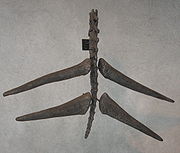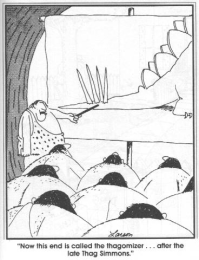
Thagomizer
Encyclopedia

Stegosauridae
Stegosauridae is a family of stegosauria, large thyreophorans. They lived longer than other Stegosaurs; while all Huayangosauridae and most of basal stegosaurs died out in Tithonian - Kimmeridgian, stegosauridae survived till Middle Cretaceous. They are usually characterized by triangular plates on...
dinosaurs
Dinosaur
Dinosaurs are a diverse group of animals of the clade and superorder Dinosauria. They were the dominant terrestrial vertebrates for over 160 million years, from the late Triassic period until the end of the Cretaceous , when the Cretaceous–Paleogene extinction event led to the extinction of...
. These spikes are believed to have been a defensive measure against predators.
Paleobiology
There has been debate about whether the spikes were used simply for display, as posited by Gilmore in 1914, or used as a weapon. Robert BakkerRobert T. Bakker
Robert T. Bakker is an American paleontologist who helped reshape modern theories about dinosaurs, particularly by adding support to the theory that some dinosaurs were endothermic...
noted that the stegosaur tail was likely much more flexible than those of other dinosaurs because it lacked ossified tendons, thus lending credence to the idea of the tail as a weapon. He also observed that Stegosaurus could have maneuvered its rear easily by keeping its large hindlimbs stationary and pushing off with its very powerfully muscled but short forelimbs, allowing it to swivel deftly to deal with attack. In 2010, analysis of a digitized model of Kentrosaurus aethiopicus showed that the tail could bring the thagomizer around to the sides of the dinosaur, possibly striking an attacker beside it.
In 2001, a study of tail spikes by McWhinney et al., showed a high incidence of trauma-related damage. This too supports the theory that the spikes were used in combat.
There is also evidence for Stegosaurus defending itself, in the form of an Allosaurus tail vertebra with a partially healed puncture wound that fits a Stegosaurus tail spike.
Stegosaurus stenops had four dermal spikes, each about 60–90 cm (2–3 ft) long. Discoveries of articulated stegosaur armor show that, at least in some species, these spikes protruded horizontally from the tail, not vertically as is often depicted. Initially, Marsh described S. armatus as having eight spikes in its tail, unlike S. stenops. However, recent research re-examined this and concluded this species also had four.
Stegosaurs with thagomizers
- Stegosaurus stenopsStegosaurusStegosaurus is a genus of armored stegosaurid dinosaur. They lived during the Late Jurassic period , some 155 to 150 million years ago in what is now western North America. In 2006, a specimen of Stegosaurus was announced from Portugal, showing that they were present in Europe as well...
is unusual because it lacks shoulder spikes (parascapular spines). - Stegosaurus armatusStegosaurusStegosaurus is a genus of armored stegosaurid dinosaur. They lived during the Late Jurassic period , some 155 to 150 million years ago in what is now western North America. In 2006, a specimen of Stegosaurus was announced from Portugal, showing that they were present in Europe as well...
also has four spikes. It was the first species discovered - Kentrosaurus aethiopicusKentrosaurusKentrosaurus is a genus of stegosaurid dinosaur from the Late Jurassic of Tanzania. Its fossils have been found only in the Tendaguru Formation of Tanzania, dated to the Kimmeridgian stage, between about 155.7 ± 4 Ma and 150.8 ± 4 Ma . Apparently, all finds belong to one species, K...
- Miragaia longicollumMiragaia (dinosaur)Miragaia is a genus of stegosaurid dinosaur. Its fossils have been found in Upper Jurassic rocks in Portugal...
, a long-necked stegosaur - Gigantspinosaurus sichuanensisGigantspinosaurusGigantspinosaurus is a genus of herbivorous ornithischian dinosaur from the Late Jurassic. It was a stegosaur found in Sichuan, China....
, a stegosaur with huge parascapular spines
Etymology

Gary Larson
Gary Larson is the creator of The Far Side, a single-panel cartoon series that was syndicated internationally to newspapers for 15 years. The series ended with Larson's retirement on January 1, 1995. His 23 books of collected cartoons have combined sales of more than 45 million...
in a 1982 Far Side
The Far Side
The Far Side is a popular single-panel comic created by Gary Larson and syndicated by Universal Press Syndicate, which ran from January 1, 1980, to January 1, 1995. Its surrealistic humor is often based on uncomfortable social situations, improbable events, an anthropomorphic view of the world,...
comic strip
Comic strip
A comic strip is a sequence of drawings arranged in interrelated panels to display brief humor or form a narrative, often serialized, with text in balloons and captions....
, in which a group of cavemen
Caveman
A caveman or troglodyte is a stock character based upon widespread concepts of the way in which early prehistoric humans may have looked and behaved...
in a faux-modern lecture hall are taught by their caveman professor that the spikes were named "after the late Thag Simmons". The term was picked up initially by Ken Carpenter, a palaeontologist at the Denver Museum of Nature and Science, who used the term when describing a fossil at the Society of Vertebrate Paleontology
Society of Vertebrate Paleontology
The Society of Vertebrate Paleontology was founded in 1940 for individuals with an interest in vertebrate paleontology. SVP now has almost 2,000 members. The society's website states that SVP "is organized exclusively for educational and scientific purposes...
Annual Meeting in 1993.
Thagomizer has since been adopted as an informal anatomical term, and is used by the Smithsonian Institution
Smithsonian Institution
The Smithsonian Institution is an educational and research institute and associated museum complex, administered and funded by the government of the United States and by funds from its endowment, contributions, and profits from its retail operations, concessions, licensing activities, and magazines...
, the Dinosaur National Monument in Utah, the book The Complete Dinosaur and the BBC documentary series Planet Dinosaur
Planet Dinosaur
Planet Dinosaur is a six-part documentary television series produced by the BBC, narrated by John Hurt, first aired in the United Kingdom in 2011, produced by VFX studio Jellyfish Pictures. It is the first major dinosaur-related series for BBC One since Walking with Dinosaurs...
.
The fate of Thag Simmons notwithstanding, dinosaurs and humans did not exist in the same era. In The Prehistory of the Far Side
The Prehistory of the Far Side
The Prehistory of The Far Side: A 10th Anniversary Exhibit is a book chronicling the origin and evolution of The Far Side , giving inside information about the cartooning process and featuring a gallery of Larson's favorite Far Side cartoons from the 1980s.- Part 1: Origin of the Species :Larson...
, Gary Larson suggests that "there should be cartoon confessional
Confessional
A confessional is a small, enclosed booth used for the Sacrament of Penance, often called confession, or Reconciliation. It is the usual venue for the sacrament in the Roman Catholic Church, but similar structures are also used in Anglican churches of an Anglo-Catholic orientation, and also in the...
s where we could go and say things like, 'Father, I have sinned – I have drawn dinosaurs and hominids together in the same cartoon.'"
Other scientific terms first used in comedy
- Horrendous Space Kablooie
- Flange of baboons
- Shmoo

